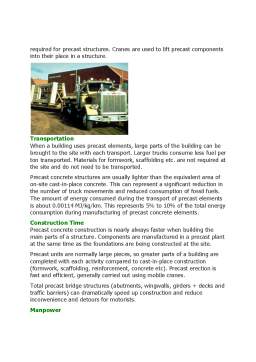Extras din referat
Environmental and manufacturing conditions at a precast concrete plant are easily monitored. The production of precast concrete elements takes place under controlled conditions in enclosed factories. This makes the control of manufacturing, waste, emissions, noise levels, etc. easy compared with the same processes at a building site. The raw material consumption is similar for similar qualities of concrete, whether the production takes place in a factory, at a ready-mix plant or at a building site. The raw material waste in precast concrete production is very small.
The use of new technologies such as self-consolidating concrete (SCC) can significantly reduce noise and vibration in the production process. The use of high-performance concrete (HPC) enables the design and production of more slender, reliable and more durable structures with function-optimized shapes. Cost and material savings in structural material consumption and natural resources can be realized through controlled production.
Forms
Precast forms are normally made of either steel or plywood. A large number of castings in forms is typical in the production of precast concrete elements in plants with savings of raw materials.
Plywood form use is limited to about 20 to 50 castings depending upon the complexity, maintenance and shape of the form. Standardized elements cast in steel forms are one step towards sustainable production. An unlimited number of castings can be made by precasting using steel forms. Standardization of precast products will save cost. Attempts by the precast industry to standardize precast cross sections are designed to save costs and increase market share by getting the maximum number of casts out of every form.
Form Oil
Mineral oil release agents can affect the health of workers, pollute the air, water and soil, be flammable, have poor biodegradability and result in hazardous waste. New form oils have been developed, containing of a mix of marine ester, medical white oil and vegetable oil. These oils are easily biodegradable and are non-toxic. Precasters use approximately 0.5 kg form oil per m3 of concrete. Mineral oils are still used, but as prices come down, precasters will change to the new form oils.
Silicone
Silicone is frequently used to seal joints in forms. No negative scientifically based ecological findings have been found regarding the life cycle of silicone sealants.
Admixtures
Admixtures can be divided into four main groups: water-reducing, air-entraining, retarders and accelerators. In addition, there are several other types of admixtures for special applications.
The purpose of admixtures is to improve concrete quality both in the fresh and hardened state.
The use of admixtures often has a beneficial effect on the environment: better durability of concrete, less consumption of cement, less energy consumption during casting, etc.
Preview document
Conținut arhivă zip
- Production, Transportation and Mounting of Prefabricated Elements.docx









